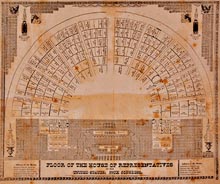Congressional Apportionment
Determining Apportionment
The Constitution assigned the original apportionment of the Representatives between the different states based on population in 1787. These numbers remained in effect for the 1st and 2nd Congresses (1789–1793). Using five different methods over time, all with the aim of dividing representation among the states proportionately, Congress based subsequent apportionments on changes in state population as recorded in each decennial census since 1790.1 Up to and including the 13th Census in 1910, Congress enacted a law designating the specific changes in the actual number of Representatives as well as the increase in the representation ratio. In 1941, Congress permanently adopted the “Method of Equal Proportion” to determine apportionment. The U.S. Census Bureau provides more information on this method of computing apportionment.
In order to keep the House at a manageable number, Congress twice set the size of the House at 435 voting Members—the then-existing number of Representatives. In 1911, Congress designated the number of Representatives to be 433, with provisions made for two additional Members when Arizona and New Mexico were admitted to the Union (see Act of August 8, 1911, ch. 5, 37 Stat 13). The 63rd Congress (1913–1915) was the first to have 435 Members. The Permanent Apportionment Act of 1929 capped the Membership at that level, creating a procedure for reapportioning state delegations in the House under “the then existing number of Representatives” (see Act of June 18, 1929, ch. 28, 46 Stat 21).
The total membership of the House of Representatives is 441 Members. There are 435 Representatives from the 50 states. In addition, five, non-voting Delegates represent the District of Columbia and the U.S. territories of Guam, the U.S. Virgin Islands, the Commonwealth of the Northern Mariana Islands, and American Samoa. A non-voting Resident Commissioner, serving a four-year term, represents the Commonwealth of Puerto Rico.



